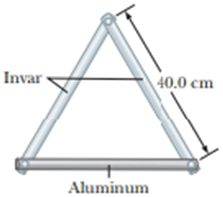
Concept explainers
Two metal bars are made of invar and a third bar is made of aluminum. At 0°C, each of the three bars is drilled with two holes 40.0 cm apart. Pins are put through the holes to assemble the bars into an equilateral triangle as in Figure P18.31. (a) First ignore the expansion of the invar. Find the angle between the invar bars as a function of Celsius temperature. (b) Is your answer accurate for negative as well as positive temperatures? (c) Is it accurate for 0°C? (d) Solve the problem again, including the expansion of the invar. Aluminum melts at 660°C and invar at 1 427°C. Assume the tabulated expansion coefficients are constant. What are (e) the greatest and (f) the smallest attainable angles between the invar bars?
Figure P18.31

(a)
Answer to Problem 19.54AP
Explanation of Solution
Given info: The distance between two holes drilled at
In the given diagram consider the right triangle that each invar bar makes with one half of the aluminum bar.
Then, the angle is,
Here,
Rearrange the above equation for
Conclusion:
Therefore, the angle between the invar bars as a function of Celsius temperature is
(b)
Answer to Problem 19.54AP
Explanation of Solution
Given info: The distance between two holes drilled at
If the temperature drops, the Celsius temperature becomes negative. The negative value of the Celsius temperature describes the contraction of the bars. So the answer is accurate for the negative temperature same as the positive temperature.
Conclusion:
Therefore, yes the answer is accurate for negative as well as positive temperature.
(c)
Answer to Problem 19.54AP
Explanation of Solution
Given info: The distance between two holes drilled at
The expression for the angle between the invar bars is,
Substitute
The value of each angle of the right angle triangle is
Conclusion:
Therefore, Yes, the answer is accurate at
(d)
Answer to Problem 19.54AP
Explanation of Solution
Given info: The distance between two holes drilled at
In the given diagram consider the right triangle that each invar bar makes with one half of the aluminum bar.
Then, the angle between invar bars and aluminum bar is,
Here,
Rearrange the above equation for
Conclusion:
Therefore, the angle between the invar bars and the aluminum bar as a function of Celsius temperature is
(e)
Answer to Problem 19.54AP
Explanation of Solution
Given info: The distance between two holes drilled at
The average coefficient of linear expansion of the aluminum is
The average coefficient of linear expansion of the invar is
The greatest angle is occur at
The equation for the angel between the invar bars is,
Substitute
Conclusion:
Therefore, the greatest attainable angle between the invar bars is
(f)
Answer to Problem 19.54AP
Explanation of Solution
Given info: The distance between two holes drilled at
The average coefficient of linear expansion of the aluminum is
The average coefficient of linear expansion of the invar is
The smallest angle is occur at
The equation for the angel between the invar bars is,
Substitute
Conclusion:
Therefore, the smallest attainable angle between the invar bars is
Want to see more full solutions like this?
Chapter 19 Solutions
Bundle: Physics for Scientists and Engineers, Technology Update, 9th Loose-leaf Version + WebAssign Printed Access Card, Multi-Term
- Please don't use Chatgpt will upvote and give handwritten solutionarrow_forwardThe kinetic energy of a pendulum is greatest Question 20Select one: a. at the top of its swing. b. when its potential energy is greatest. c. at the bottom of its swing. d. when its total energy is greatest.arrow_forwardPart a-D plarrow_forward
- The figure (Figure 1) shows representations of six thermodynamic states of the same ideal gas sample. Figure 1 of 1 Part A ■Review | Constants Rank the states on the basis of the pressure of the gas sample at each state. Rank pressure from highest to lowest. To rank items as equivalent, overlap them. ▸ View Available Hint(s) highest 0 ☐ ☐ ☐ ☐ ☐ ☐ Reset Help B F A D E The correct ranking cannot be determined. Submit Previous Answers × Incorrect; Try Again; 4 attempts remaining Provide Feedback lowest Next >arrow_forwardPart A m 2πkT ) 3/2 Calculate the integral (v) = f vƒ (v)dv. The function f(v) describing the actual distribution of molecular speeds is called the Maxwell-Boltzmann distribution, = ƒ(v) = 4π (· v²e-mv²/2kT . (Hint: Make the change of variable v² =x and use the tabulated integral foxne integer and a is a positive constant.) Express your answer in terms of the variables T, m, and appropriate constants. -ax dx n! - an+1 where n is a positive (v) = ΕΠΙ ΑΣΦ Submit Previous Answers Request Answer ? × Incorrect; Try Again; 4 attempts remaining Al Study Tools Looking for some guidance? Let's work through a few related practice questions before you go back to the real thing. This won't impact your score, so stop at anytime and ask for clarification whenever you need it. Ready to give it a try? Startarrow_forwardStarter the rule of significantarrow_forward
- No chatgpt plsarrow_forwardCar A starts from rest at t = 0 and travels along a straight road with a constant acceleration of 6 ft/s^2 until it reaches a speed of 60ft/s. Afterwards it maintains the speed. Also, when t = 0, car B located 6000 ft down the road is traveling towards A at a constant speed of 80 ft/s. Determine the distance traveled by Car A when they pass each other.Write the solution using pen and draw the graph if needed.arrow_forwardIn the given circuit the charge on the plates of 1 μF capacitor, when 100 V battery is connected to the terminals A and B, will be 2 μF A 1 µF B 3 µFarrow_forward
 College PhysicsPhysicsISBN:9781285737027Author:Raymond A. Serway, Chris VuillePublisher:Cengage Learning
College PhysicsPhysicsISBN:9781285737027Author:Raymond A. Serway, Chris VuillePublisher:Cengage Learning Principles of Physics: A Calculus-Based TextPhysicsISBN:9781133104261Author:Raymond A. Serway, John W. JewettPublisher:Cengage Learning
Principles of Physics: A Calculus-Based TextPhysicsISBN:9781133104261Author:Raymond A. Serway, John W. JewettPublisher:Cengage Learning Physics for Scientists and Engineers: Foundations...PhysicsISBN:9781133939146Author:Katz, Debora M.Publisher:Cengage Learning
Physics for Scientists and Engineers: Foundations...PhysicsISBN:9781133939146Author:Katz, Debora M.Publisher:Cengage Learning College PhysicsPhysicsISBN:9781305952300Author:Raymond A. Serway, Chris VuillePublisher:Cengage Learning
College PhysicsPhysicsISBN:9781305952300Author:Raymond A. Serway, Chris VuillePublisher:Cengage Learning Physics for Scientists and Engineers, Technology ...PhysicsISBN:9781305116399Author:Raymond A. Serway, John W. JewettPublisher:Cengage Learning
Physics for Scientists and Engineers, Technology ...PhysicsISBN:9781305116399Author:Raymond A. Serway, John W. JewettPublisher:Cengage Learning Physics for Scientists and EngineersPhysicsISBN:9781337553278Author:Raymond A. Serway, John W. JewettPublisher:Cengage Learning
Physics for Scientists and EngineersPhysicsISBN:9781337553278Author:Raymond A. Serway, John W. JewettPublisher:Cengage Learning





